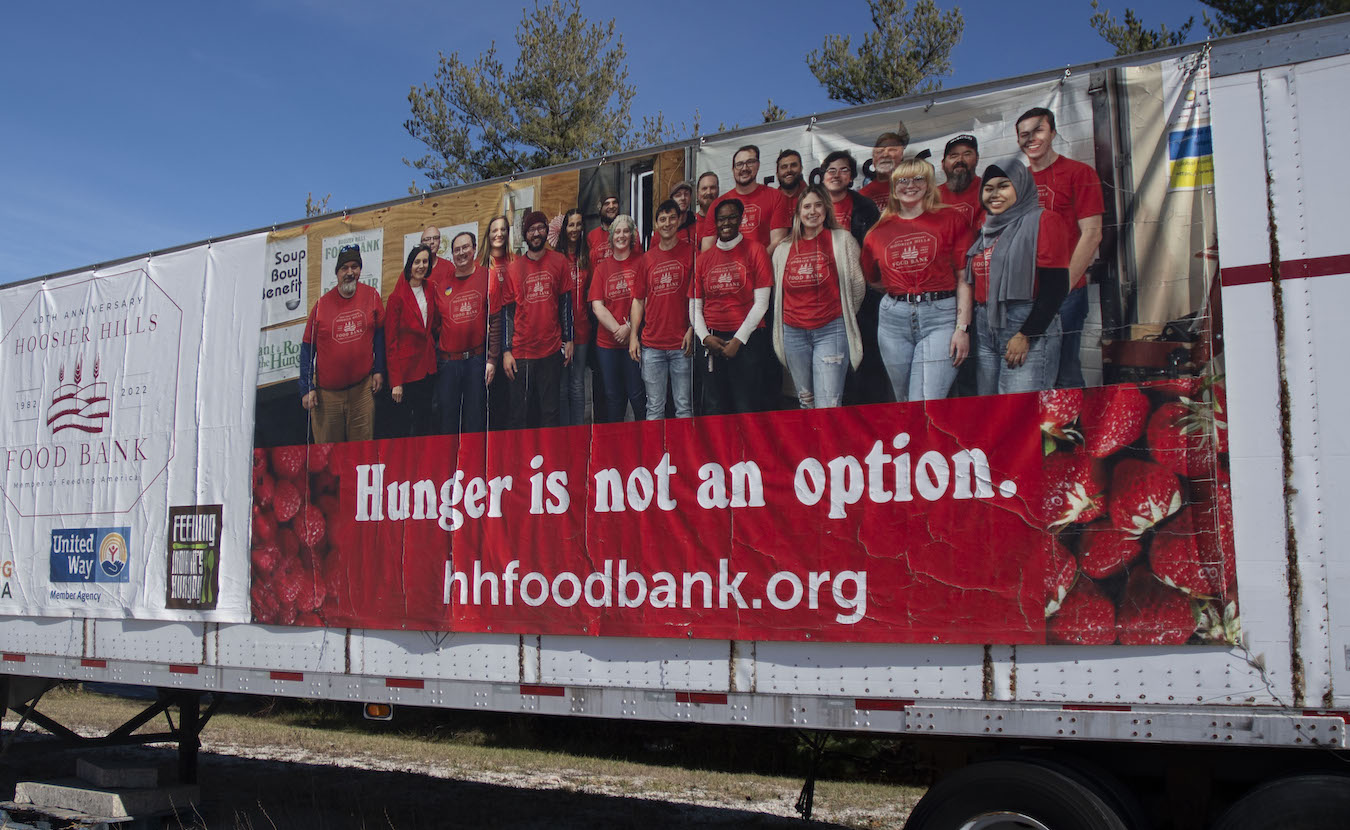Editor’s note: This is the first of two articles by Christina Avery and Haley Miller on food insecurity, which is part of the series Deep Dive: WFHB & Limestone Post Investigate. You can read more about the Deep Dive collaboration at the end of the article.

Volunteers at Community Kitchen of Monroe County wrap sandwiches and prepare sack lunches for at-risk children in Bloomington. | Photo by Olivia Bianco
On a Thursday evening in November, folks waited inside the Community Kitchen of Monroe County for a hot meal.
Some of them were older adults. Others were young children, running across the dining room with their plastic trays. While some might have been occasional or short-term patrons, using the kitchen’s services for only a few months, most, according to Executive Director Vicki Pierce, likely would be classified as chronically food insecure, meaning they lack the income and assets to maintain an adequate supply of food on their own.
In Monroe County, one out of every ten Bloomington residents cannot access the foods they need, and more than 45 percent of people say they need better access to at least one type of food, according to the most recent Bloomington Food Access Report from September 2021.
But the Community Kitchen provides only a temporary solution.
“We totally get that what we’re doing is putting a Band-Aid on every day,” Pierce said. “We’re making sure somebody has food to eat today.”
The prevalence of food insecurity
People working to fight hunger in the community say they struggle to keep up with the overwhelming demand for food and other services.
Megan Betz, CEO of Mother Hubbard’s Cupboard — a Bloomington-based food pantry and community center focusing on food accessibility and advocacy — said the Bloomington community seems to focus on various social issues in cycles.
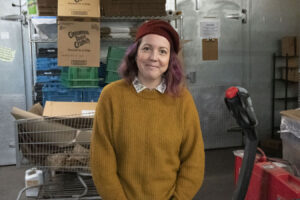
Megan Betz inside the warehouse of Mother Hubbard’s Cupboard. Betz is the CEO and president of the food pantry and community center based in Bloomington. | Photo by Olivia Bianco
“Right now, we’re looking at housing as a huge issue,” Betz said. “Unhoused people living in Bloomington is something that is getting a lot of attention and a lot of resources. It just changes so often, so sometimes it’s food insecurity, sometimes it’s housing.”
While all of these issues are important, Betz said, the back-and-forth of public dialogue about social issues can make it more difficult to address them consistently.
“Pulling all of those things together, how do we tie them together so we’re getting folks into affordable housing with incomes that are going to cover their expenses, with access to the care they need consistently?” she said. “And also making sure that the systems they have to navigate to check all of those boxes feel safe and approachable.”
Visitors at Mother Hubbard’s Cupboard often come from all walks of life, she said — parents working multiple jobs, college students struggling financially, and elderly veterans living in their cars with serious health conditions. It can feel debilitating to make what seem like small, incremental changes, but the reality is that shifting the narrative about food insecurity takes major public investment, Betz said.
“If we’re going to prioritize economic development, if we’re going to prioritize maintaining ourselves as a university town, how are we ensuring that all of those entities are also expected to invest in the well-being of everybody?” she said.
Feeding aging Hoosiers
Hoosier Hills Food Bank, located in Bloomington, collects and purchases food using community donations and state grants and distributes the food to its more than 100 member agencies in six south-central Indiana counties. Monroe County agencies that depend on the food bank include Area 10 Agency on Aging, the Boys and Girls Clubs of Bloomington, and Mother Hubbard’s Cupboard. Hoosier Hills typically receives an uptick of donations during the holidays, Senior Program and Outreach Coordinator Sydney Graham said, but food is needed year-round.

Sydney Graham, senior program and outreach coordinator for Hoosier Hills Food Bank. | Photo by Olivia Bianco
“The amount of people who are hungry went up, especially during COVID, and support went up. But then support went down, and demand did not go down,” Graham said. “We don’t have enough money. We don’t have enough food to feed everyone who is food insecure in this area.”
Graham’s work focuses on adults ages 60 and older. According to America’s Health Rankings, 9.8 percent of senior Hoosiers have faced the threat of hunger in the past year.
Hoosier Hills offers senior food boxes every two months to help older adults access free, nutritious food. About 1,000 older adults are currently signed up to receive the boxes, Graham said, which typically include either rice or pasta, cereal, juice, shelf-stable milk, a protein like canned beans or meat, and canned fruits and vegetables.
But even when programs are put in place to help with food insecurity, many older adults still struggle, she said — some of them may have issues filling out complicated paperwork, face transportation difficulties, or believe someone else needs the food more.
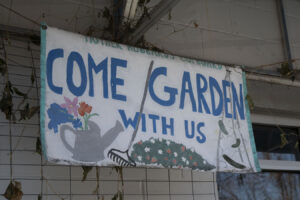
Mother Hubbard’s Cupboard has a Community Garden program that offers locally sourced food and space to grow organic produce. | Photo by Olivia Bianco
Some older adults have even come to the food bank straight after surgeries to get essentials, Graham said, because they felt they couldn’t wait to have a chance to get food. Seniors without caregivers are especially vulnerable to missing chances to get food supplies from places like a food bank, particularly if they cannot transport themselves, Graham said.
“A lot of the seniors I meet, they do put on a brave face, but sometimes you can tell that they’re struggling or they’re having a hard time,” Graham said. “I worry about them a lot.”
Pierce of the Community Kitchen of Monroe County said older adults are particularly vulnerable to food insecurity because they often live on a fixed income and face social isolation.
“My experience with our population is that oftentimes it’s folks falling through the cracks,” Pierce said. “Seniors become isolated pretty easily if they’re not connected to a faith community or a social group that’s going to keep an eye on them.”
Pierce said she also sees many families with children become food insecure. Unexpected events like a medical emergency, car accident, or lost job can quickly push a family into a state of food insecurity if they do not have sufficient savings or familial support.
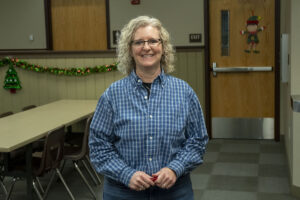
Vicki Pierce, executive director of Community Kitchen of Monroe County, in the facility’s dining room. | Photo by Olivia Bianco
“They’ve got enough but just barely,” Pierce said. “They’re one emergency from something more catastrophic.”
Food access in rural areas
Indiana University professor Daniel Knudsen, who served as an affiliate faculty member with the IU Food Institute before its closure in June 2023, said people in rural areas also face disproportionately high rates of food insecurity due to a lack of food access.
Knudsen was part of a team of investigators from the IU Center for Rural Engagement who published a report in 2021 about food insecurity among lower-income older Americans. The report, which focused on Crawford, Greene, Lawrence, and Orange counties, found that supermarkets and bigger grocery stores can be scarce and far away from community members, Knudsen said. He said Crawford County, for example, has no supermarkets — only smaller, local grocery stores, dollar stores, and farmers’ markets.
This means food pantries can be essential in rural areas, Knudsen said. But while places like Bloomington offer services every day of the week, in smaller areas it becomes more difficult to access them, especially if a person cannot travel. This forces many people to rely on farmers’ markets and dollar stores to access food, which don’t always provide the nutrition they need, Knudsen said.
“
A lot of the seniors put on a brave face, but sometimes you can tell that they’re struggling or they’re having a hard time. —Sydney Graham
”
The 2021 Bloomington Food Access Report listed high food prices, time to cook, low wages, housing costs, and transportation as the top five food access barriers experienced by Bloomington residents.
Three types of barriers exist, Knudsen said: individual, community, and structural.
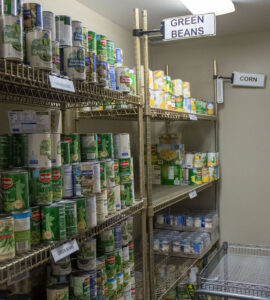
One out of every ten Bloomington residents cannot access the foods they need. Above, the cupboard at the Community Kitchen. | Photo by Olivia Bianco
Individual barriers, he said, include physical limitations, loneliness, limited income, and technological barriers. Community barriers can be issues like a lack of public transportation and the widespread closure of meal sites like community kitchens, while structural barriers can include inflation, rising food costs, and the stigma surrounding public food assistance.
Food insecurity has long-term physical and mental effects. People who lack access to the food they need are more likely to experience chronic conditions such as diabetes, heart disease, and mental health disorders due to lack of nutritious food that can promote well-being and treat or prevent disease.
Pierce said she sees the most detrimental impacts on children and older adults.
Academic, cognitive, and behavioral outcomes worsen for children who experience persistent food insecurity, according to a 2021 review of the research in the International Journal of Environmental Research and Public Health.
For older adults, a consistent lack of access to sufficient food can compound the preexisting challenges of aging, such as health or mobility issues, chronic diseases, or disabilities.
“It is especially harmful for folks at either end of the spectrum because you don’t want to have your development stunted early and limit your adult possibilities, nor when you’re at the end of your life do you want to deteriorate faster,” Pierce said.

A volunteer fills a take-home meal at Community Kitchen. | Photo by Olivia Bianco
Combating food insecurity
Solving food insecurity, Knudsen said, means working to solve the individual, community, and structural barriers.
“Even in those communities where you could identify those assets and bring those assets together, it takes some money,” he said. “Even if there are grants available that might do those things, somebody’s got to take the initiative to sit down and write the grants. It’s just one of those things where we really need to rethink what’s important to us as a nation.”
Pierce said the federal government should enforce livable wages on the state level or provide a guaranteed minimum income for citizens. She said if the focus is not on lifting households out of poverty, the issue of food insecurity will persist.
“It doesn’t matter how much they work,” Pierce said. “If you’re working for eight dollars an hour, you’re not going to be able to support yourself in a lot of places.”
Federal food assistance programs offer some relief for those in need. However, many people who need food assistance fall through the cracks of these programs, which often take an income- and asset-based approach to determining need, said Emily Weikert Bryant, executive director of Feeding Indiana’s Hungry. Feeding Indiana’s Hungry is the network of Feeding America food banks in Indiana.

Emily Weikert Bryant, executive director of Feeding Indiana’s Hungry, the network of Feeding America food banks in Indiana. | Courtesy photo
“We’re seeing more and more clients coming to the food banks and the pantries who would not be in poverty mathematically,” she said. “There’s a lot of folks who are still seeking help who aren’t eligible for the federal nutrition programs because their income is not low enough, and it’s also not high enough that they don’t need help.”
Pierce said she observes the same issue at the Community Kitchen of Monroe County.
“Because there are so many requirements for food stamps, it makes it a challenge sometimes for families to do what’s best for their family,” Pierce said.
The Supplemental Nutrition Assistance Program — otherwise known as SNAP or food stamps — provides benefits to qualifying families and individuals to buy food. The program primarily serves low-income families, the elderly, people with disabilities, and families overcoming gaps in employment or other temporary struggles.
To qualify for SNAP, a household must fall below the monthly income limit, which differs depending on the number of people in the home. Those applying must also have less than $5,000 in assets, such as bank accounts, cash, personal property, and vehicles.
While SNAP can be helpful for many, Knudsen, the IU professor, said many people who could be eligible but do not apply feel the paperwork burden of SNAP is often not worth the anticipated benefit, which can be as low as $23 per month in some cases. To apply for SNAP, a person must provide documentation such as proof of identity, age and citizenship, proof of resources and assets, proof of income, copies of medical expenses, and more.
According to the Indiana Capital Chronicle, an interim committee of the Indiana General Assembly recommended in November that legislators make the SNAP application process easier, change the asset and pre-tax requirements to a net-income requirement, and consider providing transportation or delivery to increase access to SNAP’s services.
In April 2023, Indiana Senate Bill 334 was passed into law. An effort to simplify the SNAP application process, the law made it so adults 60 and older and those with disabilities can keep their SNAP benefits for 36 months before having to recertify. The previous timeframe for continuously keeping SNAP benefits was 24 months.
“It’s hard enough to get seniors on the program,” Bryant said. “It’s often more difficult to keep them on because of the recertification processes and going through all of it again.”
Those applying for food stamps must have less than $5,000 in assets, such as bank accounts, cash, personal property, and vehicles.
In the study on lower-income older adults in rural Indiana counties, researchers recommended several community-driven solutions to combat food insecurity, including grants for food processing facilities, cooperative groceries, and transportation and food-delivery services.
Pierce said one of the challenges of addressing food insecurity overall is the assumptions people make about those who are food insecure.
The stereotype of a food-insecure person is someone who experiences homelessness and struggles with addiction or other mental health disorders, Pierce said. But in reality, a sudden change of circumstances can lead anyone who is surviving paycheck to paycheck to have trouble covering the cost of food.
“I feel like way more of us are in danger of becoming food insecure than we think about,” Pierce said. “Generally, most of us are not set up to withstand very much outside of our norm.”
Look for part 2 of this Deep Dive report on food insecurity in January.
 Deep Dive: WFHB & Limestone Post Investigate
Deep Dive: WFHB & Limestone Post Investigate
The award-winning series “Deep Dive: WFHB and Limestone Post Investigate” is a journalism collaboration between WFHB Community Radio’s Local News Department and Limestone Post Magazine. Deep Dive debuted in February 2023 as a year-long series, made possible by a grant from the Community Foundation of Bloomington and Monroe County. The Community Foundation also helped secure a grant from the Knight Foundation to extend the series for another year.
In the series, Limestone Post publishes an in-depth article about once a month on a consequential community issue, such as housing, health, or the environment, and WFHB covers related topics on Wednesdays at 5 p.m. during its local news broadcast.
In 2023, Deep Dive was chosen by the Institute for Nonprofit News as a finalist for “Journalism Collaboration of the Year” in the Nonprofit News Awards held in Philadelphia. And this year, the series brought home seven awards from the “Best in Indiana” Journalism Contest by the Society of Professional Journalists. Read more about the awards.
Here are all of the the Deep Dive articles and broadcasts so far:
Housing Crisis
Limestone Post article by Steve Hinnefeld, published February 15, 2023:
Deep Dive: Struggling with Housing Supply, Stability, and Subsidies, Part 1
WFHB reports:
Steve Hinnefeld won 1st place for “Non-Deadline Story or Series” in the Indiana Pro Chapter of the Society of Professional Journalists “Best in Indiana” Journalism Contest for parts 1 and 2 of this housing series. The staff of WFHB won 2nd place for “Coverage of Social Justice Issues” for its programs “Deep Dive: Housing Crisis.”
Housing Crisis Solutions
Limestone Post article by Steve Hinnefeld, published March 15, 2023 | photography by Jim Krause
‘No Silver Bullet’: Advocates, Officials Use Many Tactics on Housing Woes
WFHB reports:
Opioid Settlement Fund Investigations
Limestone Post article by Rebecca Hill, published April 12, 2023 | photography by Benedict Jones
How Will Opioid Settlement Monies Be Spent — and Who Decides?
WFHB reports:
IU Tree Inventory
Limestone Post article by Laurie D. Borman, published May 17, 2023 | photography by Jeremy Hogan
Trees Do More Than Add ‘Charm’ to IU Campus
WFHB reports:
Indiana Power Grid
Limestone Post article by Rebecca Hill, published June 21, 2023 | photography by Benedict Jones
The Power Struggle in Indiana’s Changing Energy Landscape
Rebecca Hill won 1st place for “Medical or Science Reporting” in the Indiana Pro Chapter of the Society of Professional Journalists “Best in Indiana” Journalism Contest for this article.
WFHB reports:
Lake Monroe Survival
Limestone Post article by Michale G. Glab, published August 16, 2023 | photography by Anna Powell Denton
How Healthy Is Lake Monroe — and How Long Will It Survive?
Michael G. Glab won 3rd place for “Business or Consumer Affairs Reporting” in the Indiana Pro Chapter of the Society of Professional Journalists “Best in Indiana” Journalism Contest for this article.
WFHB reports:
Indiana Lawmakers Attack Public Schools
Limestone Post article by Steve Hinnefeld, published September 13, 2023 | photography by Garrett Ann Walters
Local Parents, Educators Face ‘Attack’ on Public Schools from Indiana Lawmakers
WFHB reports:
On Saving the Deam Wilderness
Limestone Post photo essay by Steven Higgs, published October 18, 2023
On Saving the Deam Wilderness and Hoosier National Forest | Photo Essay
Steven Higgs won 2nd place for “Multiple Picture Group” in the Indiana Pro Chapter of the Society of Professional Journalists “Best in Indiana” Journalism Contest for this photo essay.
WFHB reports:
Food Insecurity, Part 1
Limestone Post article by Christina Avery and Haley Miller, photography by Olivia Bianco, published December 18, 2023
One Emergency from Catastrophe: Who Struggles with Food Insecurity?
Christina Avery and Haley Miller won 1st place for “Coverage of Social Justice Issues” in the Indiana Pro Chapter of the Society of Professional Journalists “Best in Indiana” Journalism Contest for this article.
WFHB reports:
Food Insecurity, Part 2
Limestone Post article by Christina Avery and Haley Miller, photos by Olivia Bianco, published March 13, 2024
‘Patchwork’ of Aid for Food Insecurity Doesn’t Address Its Cause
WFHB report:
What’s at Stake in the Debate Over Indiana’s Wetlands
Limestone Post article and photos by Anne Kibbler, published May 15, 2024
What’s at Stake in the Debate Over Indiana’s Wetlands?
WFHB reports:
- Wetlands (Part 1), May 22, 2024
- Wetlands (Part 2), May 29, 2024
- Wetlands (Part 3), June 7, 2024
- Wetlands (Part 4), June 12, 2024
Resilience Amid Hardship: Refugees Find Challenges, Opportunities in Bloomington
Limestone Post article by by Brookelyn Lambright, Karl Templeton, and Brenna Polovina from the Arnolt Center for Investigative Journalism, published August 1, 2024
Resilience Amid Hardship: Refugees Find Challenges, Opportunities in Bloomington
WFHB reports:
- Refuge in Indiana (Part 1), August 7, 2024
- Refuge in Indiana (Part 2), August 14, 2024
- Refuge in Indiana (Part 3), August 21, 2024
- Refuge in Indiana (Part 4), August 28, 2024
Apprenticeships Work for Some High School Students But Not All
Limestone Post article by Steve Hinnefeld, photography by Benedict Jones, published September 24, 2024
Apprenticeships Work for Some High School Students But Not All
WFHB reports:
- Apprenticeships (Part 1), October 9, 2024
- Apprenticeships (Part 2), October 16, 2024
- Apprenticeships (Part 3), October 30, 2024
Goal of BPD and Social Support Team Is ‘To Help People’
Limestone Post article by Haley Miller, published November 26, 2024
Goal of BPD and Social Support Team Is ‘To Help People’
WFHB reports:
- Police and Social Work, January 29, 2025
- Police and Social Work (Part 2), February 5, 2025
- Police and Social Work (Part 3), February 26, 2025
Political Polarization Hurts Communities — What Can Be Done?
Limestone Post article by Marjorie Hershey, photos by Jeremy Hogan/The Bloomingtonian, published January 26, 2025
Political Polarization Hurts Communities — What Can Be Done?
WFHB reports:
- Political Polarization, (Part 1), March 19, 2025
- Political Polarization, (Part 2), March 27, 2025
- Political Polarization, (Part 3), April 2, 2025
Mental Health Issues Are Increasing Dramatically Among Hoosier Youth
Limestone Post article by Rebecca Hill, photography by Benedict Jones, published April 3, 2025
Mental Health Issues Are Increasing Dramatically Among Hoosier Youth
WFHB reports:


